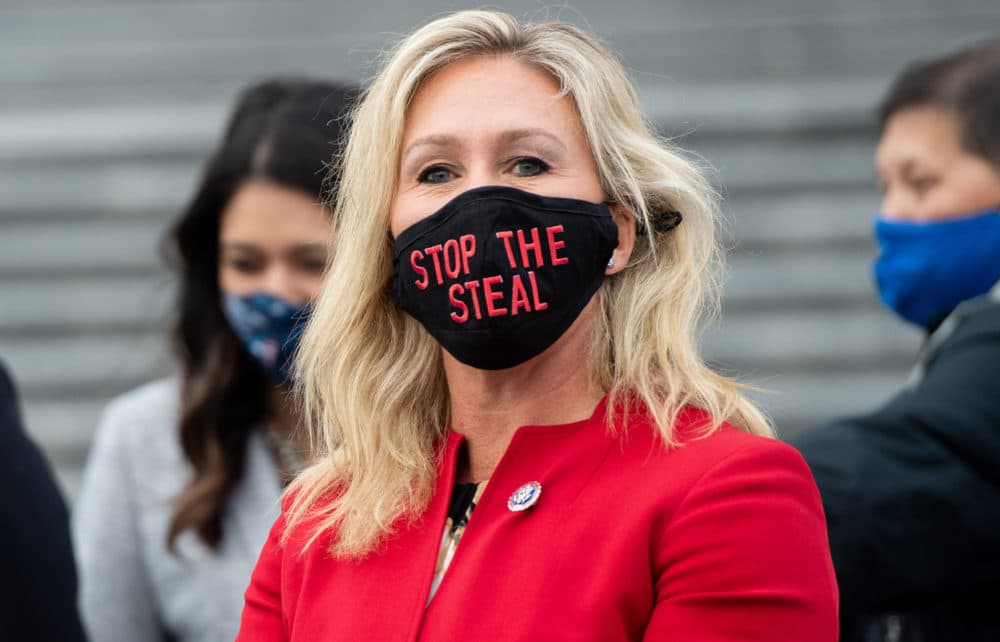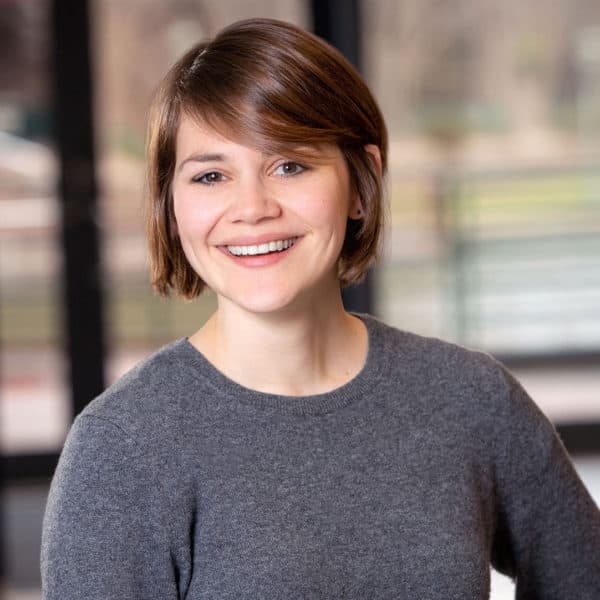Advertisement
Understanding Marjorie Taylor Greene's influence in a Republican-controlled House
Resume
Sign up for the On Point newsletter here.
Find a transcript of our conversation about the 2022 World Cup here.
Representative Marjorie Taylor Greene has become a potent force bridging the Republican Party and the far-right. But where did she come from?
"I can’t tell you how many old faculty or staff of her high school that I talked to, they had no recollection of her whatsoever," Elaina Plott Calabro, staff writer at The Atlantic, says.
We’ll trace her rise from competitive CrossFit, down the QAnon rabbit hole and all the way to Congress, where Greene is poised to wield much more power in the Republican controlled House.
“She was chagrinned to have seen that the Republicans, when they did possess power, did in her view nothing with it," Robert Draper says. "And so she intends to see a completion of the MAGA agenda that Trump had begun.”
Today, On Point: Understanding Marjorie Taylor Greene.
Guests
Robert Draper, staff writer at the New York Times. Author of several books, including Weapons of Mass Delusion: When the Republican Party Lost Its Mind. (@DraperRobert)
Tia Mitchell, Washington Correspondent at the Atlanta Journal-Constitution. (@TIAreports)
Also Featured
Elaina Plott Calabro, staff writer at The Atlantic. (@elainaplott)
Related Reading
The Atlantic: "Why is Marjorie Taylor Greene Like This?" — "She was very late. A man named Barry was compelled to lead the room in a rendition of Lee Greenwood’s “God Bless the U.S.A.” to stall for time."
Transcript: Who is Marjorie Taylor Greene?
CHAKRABARTI: Before she became Marjorie Taylor Greene, Republican representative for Georgia's 14th District, the young Marjorie Taylor was like many other teens in the 1990s. She had blonde bangs, the turtleneck sweaters. She was in the Spanish club and managed the soccer team at South Forsyth High School in Cumming, Georgia about an hour and a half north of Atlanta. She was not involved in student government.
That's according to reporting from Elaina Plott Calabro of The Atlantic. Calabro had dozens of conversations with Greene's friends, classmates, teachers, members in the community. And she says Greene was well-liked by her classmates. They describe her as nice to everyone, upbeat and with tons of confidence. But she didn't seem to make an impression on her teachers.
ELAINA PLOTT CALABRO: They had no recollection of her whatsoever. In fact, I can't tell you how many old faculty or staff of her high school that I talked to who said that the first time that her name kind of took meaning for them was when she started getting in the news constantly. And so I have a line in the piece. One teacher basically said to me, You would think that at some point there would have been like an AP government class or something or even a campaign for student council where we would have, you know, retained some glance at this person. But they sincerely didn't.
CHAKRABARTI: No one from Greene's hometown, Calabro says, expected her to become what she is today. Now, I would say that this is actually one reason why Greene's political brand is so powerful. Not being an ambitious Ivy League bound lawyer-then-politician makes to her constituents, Marjorie Taylor Greene, utterly normal, someone they recognize and can relate to.
Greene was the first in her family to graduate from college, the University of Georgia. She married her married her college sweetheart, Perry Greene. Then they moved to the Atlanta suburbs and eventually had three children. In her thirties, Greene tried religion. She was baptized into a non-denominational Christian church. She also discovered CrossFit. Here's Marjorie Taylor Greene on a local Atlanta radio show in 2015.
MARJORIE TAYLOR GREENE [Tape]: Back in 2007, a friend of mine, she asked me, she said, Do you want to try out this crazy underground cult fitness thing called CrossFit? And I was like, okay. Did the workout the best we knew how? And I loved it. I fell in love with this, like, the hardest thing I ever did, and it was the greatest thing I ever did.
CHAKRABARTI: Greene felt powerful, grounded and focused by CrossFit. At one time, she ranked 47th in the entire United States for her age group. She set her sights on the CrossFit Games, the sport's biggest competition, and later she opened her own CrossFit gym. However, Greene never made it to the CrossFit Games. Calabro says Greene's life instead took a sudden turn. She reportedly had two separate affairs with men she met at the gym. Her marriage was in trouble, and she ultimately sold her stake in her CrossFit business.
CALABRO: Every human being goes through this, I think, at some point in life, which is to say kind of feeling unmoored, unsure what your purpose is. I mean, it's why midlife crisis is such a cliche. I do think that Marjorie Taylor Greene went through her own version of that in her late thirties and early forties.
I think essentially, she sort of had a break where she said, I've got to find something new. I feel totally adrift in life. And that was when, according to people close to her, that I spent a lot of time with, she found QAnon and specifically she found the #SaveTheChildren hashtag.
CHAKRABARTI: The #SaveTheChildren hashtag is one co-opted by conspiracy theorists who believe without evidence that a network of celebrities and government officials are running a child sex trafficking ring. In other words, Marjorie Taylor Greene fell down the QAnon rabbit hole.
But in the 2016 election, Greene did not vote for Donald Trump. In fact, she didn't vote for anyone. Soon after, though, Marjorie Taylor Greene became one of the MAGA movement's biggest voices. Here she is in January of 2019, calling for a protest in Washington.
TAYLOR GREENE [Tape]: In Washington, D.C., on February 23rd ... protest and march with me. ... Really, please, I'm begging you. ... If we have a sea of people. If we shut down the streets, if we shut down everything, if we flood the Capitol building, flood all the government buildings, go inside. These are public buildings. We own them. We own these buildings.
CHAKRABARTI: Fast forward to the present day. And Marjorie Taylor Greene is entering now her second term in Congress. She's become a potent force for connecting the Republican Party to the far right. And she is poised to wield much more power in the new Republican-controlled House.
This program aired on December 16, 2022.


